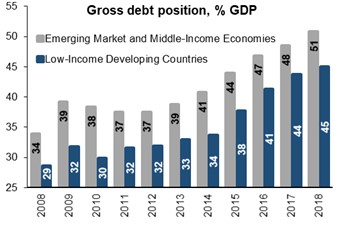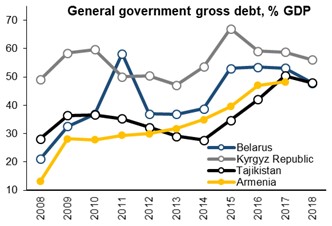
20 September 2019
Over the last ten years, the world and developing economies have significantly increased their debt burden. In 2018, public debt in these countries amounted to 51% of GDP, a significant increase compared to 2008 (34%). Low-income developing countries demonstrated a similar trend, with their public debts surging from 30% to 45% of GDP over the same period. The new rise in borrowings was driven by several factors such as the high availability of loans in the 2010s and the desire to support public expenditure and to implement large infrastructure projects for boosting economic growth. However, rising public expenditure often cause significant risks for developing countries facing deteriorating global economic environment.
| A surge in the debt burden in developing countries as a whole... | ...and the EFSD countries in particular |
 |  |
| Sources: IMF data, EFSD calculations | Sources: IMF data, EFSD calculations |
An additional challenge for low-income developing countries has to do with the financing sources. A number of countries increased their exposure to commercial debt rather than concessional loans from international financial institutions. As a result, non-concessional instruments have become an important source of financing for low-income countries’ investment projects. Overall, the share of non-concessional loans increased by more than 6% of GDP. This trends leads to the elevation of the long-term risks associated with the countries’ debt sustainability.
The EFSD countries experienced a slight decrease in the debt-to-GDP ratio in 2017-2018. However, over the last eight years, the EFSD recipient countries faced noticeable growth in debt – its share to GDP increased from 43% in 2011 to 53% in 2017. The main factors behind this increase are an unfavourable external environment and the countries’ high dependence on commodity prices and external demand. According to the EFSD Chief Economist Evgeny Vinokurov, “caution is particularly important in the current phase of the global economic cycle. The world’s economy is obviously slowing down. As a result, this may have a negative effect on export revenues and remittances. Thus, budget and debt sustainability risks deserve increased attention.”
In order to ensure sustainable economic growth in the borrowing countries, the EFSD Project Unit is implementing the framework for debt sustainability analysis and assessing the borrowers’ capacity to meet obligations. The models utilized by the Fund determine not only the country’s need for additional financing but also its solvency. The DSA models are adjustable to different scenarios, which, coupled with their transparency and predictive functions, makes them an indispensable instrument to analyse the debt burden. The EFSD Project Unit intends to develop extensive stress-testing considering a variety of external and internal macroeconomic scenarios.
Debt sustainability models are expected to become an important tool in building dialogue between the EFSD and its recipient countries with the aim of finding optimal country-specific solutions.